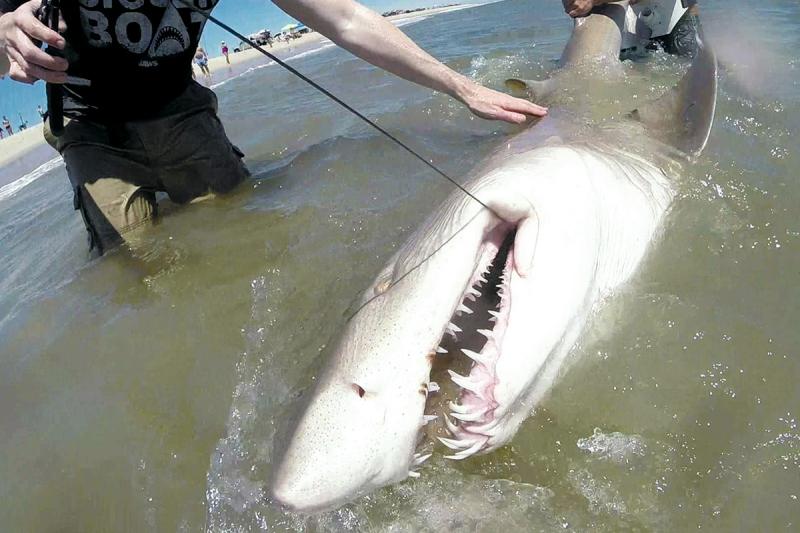Hammer time
OK, so before you totally freak out, these hammerhead sharks are about twenty-four inches long. They are puppies at best. I am sure the parents aren’t far off since they do come close to shore to have their pups. Remember the hammerhead that showed up in the surf last year in Ocean City? Then it was in the bay and people were following it around. That got some people excited. Many wanted to see it, some wanted to catch it, and others wanted to protect it so it could go back out to sea. It was trending with its own hashtag #ocshark! It did eventually go out to sea, and then everyone forgot all about it until that article popped up again in the social media news feeds in the last couple of weeks.
That is last year’s shark. One of these hammerhead sharks washed up in Ocean City, as it was giving birth. People put the baby hammerhead sharks in the water and the mother hammerhead shark back in the water, but it washed up again on Fenwick Island’s town beach and was buried that morning before anyone could determine cause of death. The fact it had a long leader attached to a hook sticking out of its mouth was determined, by many Facebook comments, to be its cause of death, we agreed. These little ones are this year’s, so far anyway.
I have had several people ask me if it is okay to handle these sharks out of the water, unlike the prohibited species. It is fine to handle them, just remove the hook and place them back in the water. Do not throw the shark or fish for that matter like many people do. That will damage them internally and kill them eventually. They are hitting top and bottom rigs and mullet rigs because of the smaller hooks and cut or fresh baits. The regulations for hammerheads from land via DNREC for Delaware are “Great hammerhead, scalloped hammerhead, smooth hammerhead … Jan. 1 -May 14 … July 16 – Dec. 31… 78 inches FORK LENGTH. Shore anglers only 1 shark of any species per angler, except 1 additional bonnethead and one additional Atlantic sharpnose per shore angler.”
Releasing Prohibited Sharks In The Surf In Delaware
A lot of people are catching sharks, some are targeting sharks, while others are just fishing for whatever bites. Dead fish on a hook is a good way to catch a shark, something anyone can do. How you release the shark is the real challenge. DNREC advises that if you don’t know the shark species then let it go. You are supposed to release the shark in the safest manner for both the angler and the animal. This way you aren’t removing a prohibited species from the water. Now how do you get the hook out of the shark’s mouth if you have to leave it in the water? The simple answer is to cut the line, and let the hook rust out and call it a day. The more involved answer is to get in the water with the shark and remove the hook there, in their house. That takes a crew and is rather involved, but is not necessary.
DNREC says: “Anglers are prohibited from landing and keeping protected sharks, including sand tiger and sandbar sharks. Due to their low reproductive rate and overfishing, possession of either species is prohibited. Hook-and-line anglers cannot remove from the water any sand tiger shark or sandbar shark, or any other prohibited species of shark. Prohibited sharks must be immediately released in a manner that will ensure maximum probability of survival.” One thing that has everyone confused: You don’t have to get in the water to release a shark. You can just cut the line. The reason Cody Gallien, Ethan Henry and crew gets in the water is to either remove the hook if they can, if not they cut the line close to the hook, or even cut the hook. They could just get the shark as close as possible (or allowed) and then cut the line and let the shark swim away. But the shark will have a lot of line hanging out of its mouth, even though the hook will rust out in no time. That line can cause serious problems for the shark. Going in the water to remove the hook is better for the shark, but the jury is out on how much “better” it is for the angler. I will admit it is a bit of a thrill to be that deep with a large sand tiger shark, but it is also a thrill to catch one in a boat. Either way some fish for the thrill and others fish for the fun. Doing it responsibly is the key factor. If that means you get in the water with the shark so you feel better about the release then go for it, just make sure you know what you are doing. But you don’t have to release a shark this way; just cut the line.
A sure sign of summer
One of the bonuses of summer hibernation is when these little guys show up. Old Inlet Bait and Tackle just reported a Pompano caught in the surf. “Jim Blasetto of Chadds Ford PA landed and released this 12 inch pompano on the beach at 3Rs Road yesterday. It hit a bloodworm” I know they are hitting them south of us but this is the first pompano caught this year in Delaware. Those are good eats. Cut-n-gut then grill that puppy and eat around the bones. Delicious! If there is one there are more they are a schooling fish. This one was caught on real bloodworms, so Fishbites should do just as well they usually do. Use a top and bottom rig with sharp hooks. Look for the Diamond State Custom Tackle top and bottom rigs with owner hooks. Good to see pompano here now, a little early but that is fine. Everything else was too, well, except croaker, now we just need some big croaker, which are a tad late. Plenty of small ones out there. This big pompano is perfect eating size, in case you catch a few. Delaware does not have a creel or size limit on these, they are here with the Gulf Stream. Bring on the weird summer fish, can’t wait to see all the crazy catches. I’ll tell you about summer hibernation later, it’s complicated.
Fishing is getting better
Bigger spot are being caught at the Cape Henlopen Fishing pier. Bloodworms or Fishbites is the trick and there are tons of other smaller fish around. Back in the day, live spot was the ticket for big tide runners or weakfish. Live lining them now is good for big flounder. Some anglers will freeze them for striped bass season. I know many people that eat the large ones. They are an excellent pan fish from the sea. Also at the Cape Henlopen pier are short striped bass, kingfish, croaker, pig fish, and weakfish. There have been more throwback flounder than keepers. The incoming into the outgoing tide is the best at the pier so you have water to fish. Drop your line near the pier poles or along the area between the poles. Most of the fish will move around the pier poles using the structure for cover and to hunt food. You will see schools of fish moving around the flats. Be careful casting! Make sure kayaks, SUPS, or waders are clear. Many fly fishermen wade the flats to fish, don’t cast near them, you have the whole pier area and structure to fish. Always check your back cast too and make sure no one is walking into it, not everyone on the pier is an angler. Most of the kayakers are just coming back from out front around the old pier poles or the inner wall and flats. In some states casting from piers is not allowed for safety concerns. Recently some people were overheard saying they were trying to cast a sinker at a kayaker from the pier. They could kill someone doing that, if you see anything like that let the folks in the store know so they can call a ranger.
Needlefish are showing up around the surf, you really see a lot of them at night under the lights. They are fun to catch on light gear, but hard to hook. That bony mouth is hard to set a hook into. Small silver spoons with good treble hooks will work. Needlefish will hit the one ounce spoons frequently. They will hit flies but again it is hard to set a hook. It is like catching a skinny angry pickerel. They are great bait for striped bass, and horrible for the table.
Cutting them up for cut bait is a little messy, they are a bit slimy. Some people use them for bait, they are just a fun alternative to catch on a hot summer day. Really fun on an ultralight setup for bass fishing. That setup is fun with shad and small blues as well. The shad at the Indian River inlet has been some fun action same for the Oceanic Pier in Ocean City.
Hog chokers are in the surf at Broadkill Beach and other Delaware Bay beaches. Hitting bloodworms on top and bottom rigs. Not much there for eating, but I have heard they are tasty. Problem is they don’t get very big, just a cool fish to add to your life list.
They are in the sole family and look like tiny flounder. It is rumored the name is from the fact hogs would feed on the fish when discarded on the beaches as by catch back in the day, they had a hard time swallowing the fish due to its rough scales. Hence the name hog choker.
Lot of small croakers, sand perch, striped bass, eels, and kingfish along the Delaware Bay beaches. Bloodworms are the best baits and use small hooks. Circle hooks are always the best so you don’t have to set the hook and it just grabs the fish. Setting a circle hook is a good way to rip its head off or at the very least lose the fish. Have a safe weekend, stay hydrated (with water) it is brutal out there.















































